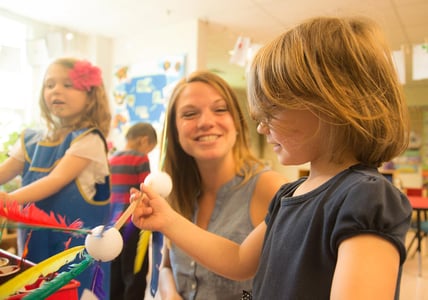
Imagine that you are a child walking into a classroom for the first time. Think about how you might feel. Are you scared? Confused? Excited?
What happens in those early moments in the classroom has the potential to shape your feelings about being there – and perhaps about school in general. What if the teacher is busy with other children and doesn’t notice you? What if you start to cry and the teacher tells you that you’re too old to cry? How might you feel about having to go back the next day?
The Impact of Educator-Child Interactions
To think about this a bit more, let’s look at Julia, a three-year-old who is about to start her first day of school. As she walked to school with her mom, she was feeling pretty excited, but once they arrived at the building, she started to feel anxious. She looked around the room and saw lots of children – far more than she was used to at her family child care home where she had been for the past two years. Julia held onto her mother’s hand tightly. She wasn’t sure she wanted to go in.
One of the teachers noticed her hesitation and came right over. She got down to Julia’s eye level and talked to her in a calm, soothing voice. She told that she was glad that Julia had come to school and told her about the other children and the kinds of things she could do at school. The teacher smiled at Julia and told her that she would help her meet new friends and make sure that she would know what to do. After several minutes, Julia took the teacher’s hand and walked over to join a group of children who were playing Duck, Duck, Goose, one of her favorite games.
Be Aware of the Student’s Perspective
By coming over and talking to Julia, the teacher set the stage for a positive teacher-child relationship. Those small interactions told Julia that the teacher was aware of her feelings and was there to support her, leading to sense of security that allowed her to say good-bye to her mom and explore her surroundings.
Imagine that Julia’s teacher also helped her find her cubby and put away her things (while excitedly telling her how much she like the new backpack that Julia had picked out for this special day). Then imagine that the classroom was prepared with interesting and engaging materials and that the teacher joined Julia as she explored the new environment, encouraging her to play with other children. She also made sure that Julia knew exactly what was going to happen during the day, so she wasn’t surprised when they went to another room or activity. Thanks to her teacher’s support, Julia learned when they were going to get a snack, use the bathroom, and play outside! Imagine that all children have such a positive experience on their first day at a new school!
Teaching is all about relationships. Relationships are built upon moment-to-moment interactions, those shared experiences and forming of expectations for how someone will act towards others. Will they be responsive or dismissive, connected and warm, or scary and unpredictable?
Learn Effective Teacher-Child Interactions
Effective interactions, as defined by the CLASS, help build relationships that support children's development. We can measure the quality of those interactions and provide support to build stronger and more positive connections. If you'd like to learn more about how CLASS supports interactions in classrooms and improves student outcomes, reach out!
